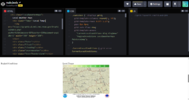So, Instead of asking everyone individually, I decided to create a thread for developers. Let me start of by saying this is for anyone. A little about myself, I am a college student and halfway completed my bachelors in software engineering with a minor in climate data analytics. I am creating this forum in hopes to find others in the similar field and asperations.
What I am currently doing is:
What I hope to improve in the future is:
I hope at some point to upload the project to GitHub for other students or researchers to add.
Anything data related is welcomed. We all can learn something. I know one user said he was able to use PowerPoint to build animations. I would love to know how he got that to happen.
What I am currently doing is:
- Creating a JavaScript data visualization viewer
- Working with various software language like ie. Java, Python, JS and many libraries.
- I am using a API
- Creating my own maps using shapefiles for a universal grid.
- Only using my local server, eventually I would like to begin using AWS.
- Other methods of data distribution geoJson, jQuery, and possibly using a custom restful API.
What I hope to improve in the future is:
- I have began working on a custom algorithm that would reduce the virga output on radar.
- Create a custom algorithm that would reduce snowfall rates to a more climate average atmosphere.
- A better way of importing live data feed from gib2 files.
I hope at some point to upload the project to GitHub for other students or researchers to add.
Anything data related is welcomed. We all can learn something. I know one user said he was able to use PowerPoint to build animations. I would love to know how he got that to happen.









